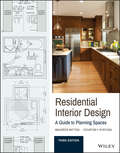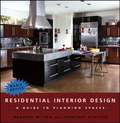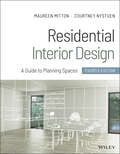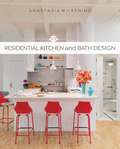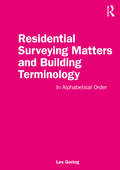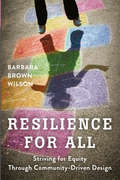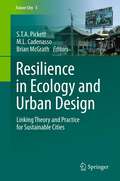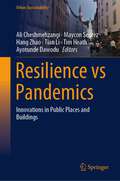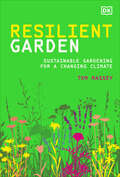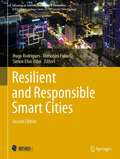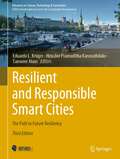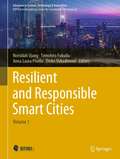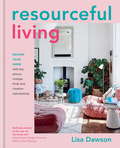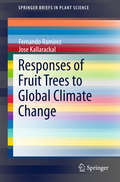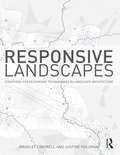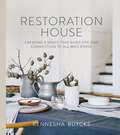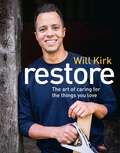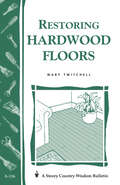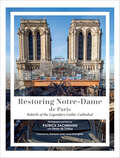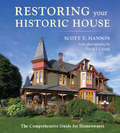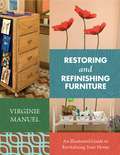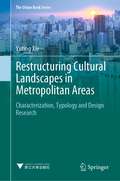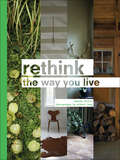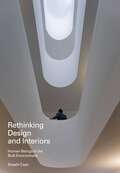- Table View
- List View
Residential Interior Design: A Guide To Planning Spaces
by Maureen Mitton Courtney NystuenA practical approach to planning residential spaces Residential Interior Design: A Guide To Planning Spaces is the industry-standard reference for all aspects of residential space planning, with a practical focus on accessible design, ergonomics, and how building systems affect each space. This new third edition has been updated with the most recent code information, including the 2015 International Residential Code and the International Green Construction Code, and new content on remodeling. Packed with hundreds of drawings and photographs, this book illustrates a step-by-step approach to design that applies to any residential space, and ensures that the most important factors are weighted heavily in the decision making process. Daily use is a major consideration, and the authors explore the minimum amount of space each room requires to function appropriately while examining the host of additional factors that impact bedrooms, bathrooms, kitchens, hallways, and more. Detailed information about accessibility is included in each chapter, making this book a reliable design reference for "aging in place" and universal design. The new companion website features teaching tools and a variety of learning supplements that help reinforce the material covered. Interior design is a fundamental component of a residential space, and a required skill for architecture and design professionals. This book is a complete reference on all aspects of residential design, and the factors that make a space "work." Design spaces with primary consideration of daily use Account for building systems, accessibility, human factors, and more Get up to date on the latest residential interior building codes Plan interiors for any home, any style, and any budget Designing a residential interior is about more than choosing paint colors and furniture—it's about people, and how they interact and use the space. It's about shaping the space to conform to its function in the best possible way. Residential Interior Design provides clear, comprehensive guidance on getting it right every time.
Residential Interior Design: A Guide to Planning Spaces
by Maureen Mitton Courtney NystuenA Room-by-room guide to home interior design More than a decorating guide, Residential Interior Design teaches the fundamental skills needed to plan interior spaces for all types of homes, in all decorative styles, from remodeling to new construction. Taking a step-by-step approach, this valuable primer reviews all aspects of interior architecture as it relates to human factors and daily use. Authors and interior designers Maureen Mitton and Courtney Nystuen explore the minimal amount of space necessary in order for rooms to function usefully, from the kitchen to the bathroom, the bedroom to the hallway, and every room in between. Packed with hundreds of drawings and photographs, this valuable tool is brimming with useful information regarding codes, mechanical and electrical systems, the Americans with Disabilities Act, accessibility codes, special considerations for multi-family dwellings, and a variety of additional factors that impact each type of room and its corresponding space. With a focus on quality of design over quantity of space, Residential Interior Design is the first stop to designing equally efficient and attractive rooms.
Residential Interior Design: A Guide to Planning Spaces
by Maureen Mitton Courtney NystuenDiscover a practical guide to residential space planning, in this room-by-room guide with up-to-date info on accessibility, ergonomics, and building systems In the newly revised Fourth Edition of Residential Interior Design: A Guide to Planning Spaces, an accomplished team of design professionals delivers the gold standard in practical, human-centered residential interior design. Authors Maureen Mitton and Courtney Nystuen explore every critical component of interior architecture from the perspective of ergonomics and daily use. The text functions as a guide for interior design students and early-career professionals seeking a handbook for the design of livable, functional, and beautiful spaces. It includes hundreds of drawings and photographs that illustrate key concepts in interior design, as well as room-by-room coverage of applicable building codes and sustainability standards. The authors also cover all-new applications of smart building technology and updated residential building codes and accessibility standards. The book also includes: A thorough introduction to the design of interior residential spaces, including discussions of accessibility, universal design, visibility, sustainability, ergonomics, and organizational flow In-depth examinations of kitchens, bathrooms, and the fundamentals of residential building construction and structure Comprehensive explorations of entrances and circulation spaces, including foyer and entry areas, vertical movement, and electrical and mechanical considerations Practical discussions of bedrooms, leisure spaces, utility, and workspaces An overview of human behavior and culture related to housing Updates made to reflect changes in the 2021 International Residential Code (IRC) The latest edition of Residential Interior Design: A Guide to Planning Spaces is ideal for instructors and students in interior design programs that include interior design, residential design, or residential interior architecture courses. This edition provides updated content related to CIDA standards in human centered design, regulations and guidelines, global context, construction, environmental systems, and human wellbeing. It’s also an indispensable resource for anyone preparing for the NCIDQ, the interior design qualification exam.
Residential Kitchen and Bath Design
by Anastasia WilkeningResidential Kitchen and Bath Design provides students with a core knowledge of this interior design sub-specialty and equips them with skills they can use to create residential kitchens and baths that are both functional and beautiful. The text begins with an overview of the kitchen and bath industries, covering the designer's role at each step of the design process. It then goes on to explain functional and ergonomic considerations in the arrangement of appliances, fixtures, and storage, and provides detailed instruction on communicating designs to clients and tradespeople using floor plans, models, and other renderings. Issues related to codes, regulations, and costs are reviewed, as are the NKBA planning guidelines for space planning and drawing plans for kitchens and bathrooms.
Residential Surveying Matters and Building Terminology: In Alphabetical Order
by Les GoringThis is an ideal reference book for students (undergraduates and postgraduates) studying Building Surveying, Quantity Surveying, or Architecture, etc. It should also be of use to the Construction-related legal profession, Property Managers and Letting Agents. Builders (and homeowners, interested in identifying faults in their property), should also benefit from this book. Residential Surveying Matters and Building Terminology covers a wide range of new and old building terms, techniques, technologies and materials, but much more extensively than the average dictionary. The alphabetical format makes it easy to check up on terms and subject-areas quickly – and the detailed coverage (including helpful drawings by the author) provides clear guidance to the reader. This book covers a multitude of subject-areas, including condensation problems, cellar rot, wet rot and dry rot, thermal cracks, settlement cracks, metal wall-tie corrosion-and-expansion cracks, subsidence cracks, roof-spread recognition, bulging- and/or leaning-walls, etc. Further subject areas include inspecting and analysing residential building-structures, both internally and externally; appraising underground drainage systems; and personal commentary on survey report writing.
Resilience for All: Striving for Equity Through Community-Driven Design
by Barbara Brown WilsonIn the United States, people of color are disproportionally more likely to live in environments with poor air quality, in closeproximity to toxic waste, and in locations more vulnerable to climate change and extreme weather events.In many vulnerable neighborhoods, structural racism and classism prevent residents from having a seat at the table when decisions are made about their community. In an effort to overcome power imbalances and ensure local knowledgeinforms decision-making, a new approach to community engagement is essential.In Resilience for All, Barbara Brown Wilson looks at less conventional, but often more effective methods to makecommunities more resilient. She takes an in-depth look at what equitable, positive change through community-drivendesign looks like in four communities—East Biloxi, Mississippi; the Lower East Side of Manhattan; the Denbyneighborhood in Detroit, Michigan; and the Cully neighborhood in Portland, Oregon. These vulnerable communities haveprevailed in spite of serious urban stressors such as climate change, gentrification, and disinvestment. Wilson looks at how the lessons in the case studies and other examples might more broadly inform future practice. She shows how community-driven design projects in underserved neighborhoods can not only change the built world, but also provide opportunities for residents to build their own capacities.
Resilience in Ecology and Urban Design
by S.T.A. Pickett Brian Mcgrath M. L. CadenassoThe contributors to this volume propose strategies of urgent and vital importance that aim to make today's urban environments more resilient. Resilience, the ability of complex systems to adapt to changing conditions, is a key frontier in ecological research and is especially relevant in creative urban design, as urban areas exemplify complex systems. With something approaching half of the world's population now residing in coastal urban zones, many of which are vulnerable both to floods originating inland and rising sea levels, making urban areas more robust in the face of environmental threats must be a policy ambition of the highest priority. The complexity of urban areas results from their spatial heterogeneity, their intertwined material and energy fluxes, and the integration of social and natural processes. All of these features can be altered by intentional planning and design. The complex, integrated suite of urban structures and processes together affect the adaptive resilience of urban systems, but also presupposes that planners can intervene in positive ways. As examples accumulate of linkage between sustainability and building/landscape design, such as the Shanghai Chemical Industrial Park and Toronto's Lower Don River area, this book unites the ideas, data, and insights of ecologists and related scientists with those of urban designers. It aims to integrate a formerly atomized dialog to help both disciplines promote urban resilience.
Resilience vs Pandemics: Innovations in Public Places and Buildings (Urban Sustainability)
by Ali Cheshmehzangi Ayotunde Dawodu Tim Heath Hang Zhao Maycon Sedrez Tian Li“Resilience vs Pandemics: Innovations in Public Places and Buildings” explores innovative solutions for architecture and public places during and after the pandemic. Additionally, the authors contribute to the documentation of architectural and social transformations that have been prompted by previous transmissible diseases, as this knowledge can inform responses to future pandemics. In this volume, the chapters present critical, exploratory, multi- and interdisciplinary, and cutting-edge research approaches; with a particular focus on the effects of COVID-19 and other highly transmissible diseases on the design, use, performance, and perception of the built environment, particularly at the building scale. This volume aims to organize a collection of scientific studies, reviews, analysis, recommendations, and solutions in the fields of urban design, architecture, design, landscape design, etc. The overarching goal is to document new approaches to create and enhance built environment resilience. Chapters shed light on novel methods, tools, processes, regulations, behaviours, and other relevant details contributing to a comprehensive understanding of this crucial issue. The two scales of the built environment under consideration are: (1) Public Places, including research on transformations (death, emergencies, changes), requirements, adaptability, usability, virtual immersion, historical perspectives, interactivity, shifts in use and programs, etc.(2) Buildings, including regulations, shifts in use and program, non-pharmaceutical interventions, human interactions, and human-machine interfaces. The book covers a wide range of studies, including physical and non-physical studies, which may refer to the city infrastructure, green/blue spaces, housing, policy-making, health services, social and economic issues, etc. The findings and results of various global case study examples contribute to the decision-making of governments, organizations, and institutions, as well as inspire scholars and future research for developing resilience in the post-pandemic era.
Resilient Garden: Sustainable Gardening for a Changing Climate
by Tom MasseyCreate a beautiful, climate-resilient, sustainable garden that will take your outdoor space into the future.As we live with an increasingly changing climate, summer droughts, winter waterlogging, high winds, erratic frosts, and frequent pests are challenges that many gardeners may face in different regions around the world. This cutting-edge book-grounded in the latest RHS research-shows you how to work with the environment and adapt your outdoor space to give it exactly what it needs to flourish ... and to give wildlife a helping hand, too.Discover how a hedge can reduce noise and trap pollution, how a patio affects waterlogging, how to create a vertical green wall of homegrown vegetables, how to harvest your rainwater, and much more.Award-winning garden designer Tom Massey shares essential tips on how to analyze your backyard, looking at everything from soil type to sun exposure, before recommending practical projects and plant choices that will be perfect for your plot. Together we can garden more sustainably; mitigate extreme weather conditions; and ensure our outdoor spaces remain resilient, beautiful, inspiring places to enjoy for years to come.
Resilient and Responsible Smart Cities (Advances in Science, Technology & Innovation)
by Simon Elias Bibri Hugo Rodrigues Tomohiro FukudaThis book gathers current research studies which explore new technologies in architecture and urban practices which ensure the efficient management of cities’ infrastructures and provide new solutions to the complex complications that may result in the tackling of challenges of population density, traffic planning, and city planning at the neighborhood scale or rather the scale of buildings and everyday life. It offers a path towards city resilience and sustainable infrastructure with the aim of meeting the demands of mega-cities. The primary audience of this book will be academics and professionals from the fields of architecture, urban planning, civil engineering, computer sciences, and mathematics. The book will aid them in their contributions to the implementation of sustainable development goals.
Resilient and Responsible Smart Cities: The Path to Future Resiliency (Advances in Science, Technology & Innovation)
by Eduardo L. Krüger Tanweer Alam Hirushie Pramuditha KarunathilakeThis book is a compilation of diverse, yet homogenic, research papers that discuss current advances in Earth Observation and Geospatial Information Technologies to tackle new horizons concerning the digitization and information management in smart cities’ infrastructures. The book also tackles the challenges faced by urban planners by the new mega-cities and proposes a series of solutions to resolve complex urban issues. It suggests enhancing the integration of disciplines, thus, bringing together architects, urban planners, civil engineers, landscape designers and computer scientists to address the problems that our cities are facing. This book is a culmination of selected research papers from IEREK’s fourth edition of the International Conference on Future Smart Cities (FSC) and the fourth edition of the International Conference on Resilient and Responsible Architecture and Urbanism (RRAU) held online in collaboration with the XMUM, Selangor, Malaysia (2021).
Resilient and Responsible Smart Cities: Volume 1 (Advances in Science, Technology & Innovation)
by Norsidah Ujang Tomohiro Fukuda Anna Laura Pisello Dinko VukadinovićThis book focuses on the ways in which resiliency can foster the transformation of cities. There is a growing need for our cities to be transformed into “smart” cities; in this regard, tremendous efforts are called for in order to face the environmental challenges that play a major role in the creation or transformation of cities and environments. This book covers a broad range of applications and approaches that are “smart” and “resilient,” which, when combined, offer much more flexibility concerning the future of our cities. Consequently, this simple combination, which is producing sweeping changes around the globe, has attracted considerable attention from scholars and decision-makers alike.
Resourceful Living
by Lisa DawsonIt's often thought that restyling your space comes with a hefty price tag and unavoidable waste. But in Resourceful Living, award-winning interiors blogger Lisa Dawson shows how, with a little creativity, you can revamp your home with existing pieces, vintage finds and key purchases. The clever ideas in this beautiful book cover:- The most important ways we use our homes, from eating to sleeping, living and working.- The Basics of steering clear of interiors 'fast fashion', multi-purposing furniture and making the most of what you have.- Styling Your Home with simple solutions for re-imagining each room, from gallery walls to home bars, repainted storage to retro accessories.Including her top ten key vintage buys and tips for in-store and online thrifting, Lisa's inspiring advice shares the fun of creative sourcing as a more sustainable way to keep your home feeling fresh.'Resourceful Living feels like reading a recipe book, not only because of the delicious interiors images, but because of the simple ingredients and easy methods that are shared to achieve beautiful living spaces for yourself.' Melanie Sykes'I've been a long-time fan and follower of Lisa's interiors tips. This book really is super practical as well as beautiful - perfect for anyone looking to be more interiors savvy.' Rachel Khoo
Responses of Fruit Trees to Global Climate Change
by Fernando Ramírez Jose KallarackalGlobal climate change is expected to produce increased carbon dioxide levels in the atmosphere, higher temperatures, aberrant precipitation patterns and a host of other climatic changes that would affect all life on this planet. This review article addresses the impact of climate change on fruit trees and the response of the trees to a changing environment. The response of fruit trees to increasing carbon dioxide levels, phenological changes occurring in the trees themselves due to increased temperature and the lower chilling hours especially in the temperate regions, ecophysiological adaptations of the trees to the changing climate, impact of aberrant precipitation, etc. are reviewed. There is very little data on the impact of rising CO2 levels on fruit tree performance or productivity including the temperate region. Based on a large number of observations on the phenology, there is reason to believe that the flowering and fruiting of most species have advanced by quite a few days, but with variations in different crops and on different continents. The chilling hours have also grown shorter in many regions, causing considerable reductions in yield for several species. In the tropics, there is very little work on fruit trees; however, the available data show that precipitation is a major factor regulating their phenology and yield. The ecophysiological adaptations vary from species to species, and there is a need to develop phenological models in order to estimate the impact of climate change on plant development in different regions of the world. More research is also called for to develop adaptation strategies to circumvent the negative impacts of climate change.
Responsive Landscapes: Strategies for Responsive Technologies in Landscape Architecture
by Justine Holzman Bradley E CantrellThe sensing, processing, and visualizing that are currently in development within the environment boldly change the ways design and maintenance of landscapes are perceived and conceptualised. This is the first book to rationalize interactive architecture and responsive technologies through the lens of contemporary landscape architectural theory. Responsive Landscapes frames a comprehensive view of design projects using responsive technologies and their relationship to landscape and environmental space. Divided into six insightful sections, the book frames the projects through the terms; elucidate, compress, displace, connect, ambient, and modify to present and construct a pragmatic framework in which to approach the integration of responsive technologies into landscape architecture. Complete with international case studies, the book explores the various approaches taken to utilise responsive technologies in current professional practice. This will serve as a reference for professionals, and academics looking to push the boundaries of landscape projects and seek inspiration for their design proposals.
Restoration House: Creating a Space That Gives Life and Connection to All Who Enter
by Kennesha BuycksDiscover how to make purposeful design decisions that create renewing spaces for you to enjoy with family and friends.You don't have to live in your dream house to make your living spaces feel more like home. Home is meant to be a place to belong. A place to gather and connect. A place of beauty. A place to restore your soul.In Restoration House, author and designer Kennesha Buycks will encourage you to embrace your home and your story so you can create mindful spaces that give life to you, your loved ones, and all who enter. Tips from Restoration House have been featured in Better Homes and Garden, Apartment Therapy, Design Sponge, and The Washington Post. Kennesha will teach you how to:Make the best out of your living space, whether you're renting or a homeownerCreate a home your visitors will feel comfortable inDecorate your home on a budgetMake purposeful design decisions that are beautiful and functional Restoration House is ideal for:Christian women of all ages who want to make their houses feel more like homeHousewarming gifts, Mother's Day, birthdays, and holiday gifting Creating a restored home—the kind that you and your loved ones want to return to again and again—is as much about making everyone who enters feel cared for and comfortable as it is about creating a beautiful space. Restoration House will help you make purposeful design decisions as you create renewing spaces to enjoy with family and friends. Whether you live in your dream house or you&’re still dreaming about it, you can feel at home in the home you have.
Restore: The instant Sunday Times bestseller from the Repair Shop’s woodworking expert
by Will KirkThe art of caring for the things you love ...Caring for the items you love around the home is easier - and more rewarding - than you think. In his first book, The Repair Shop's resident woodworking expert Will Kirk takes you on a tour of the basics of wood care and restoration, from first steps and quick fixes around the home to getting stuck into larger projects over a weekend.Whether you are fixing something you have had for years or upcycling something new, Restore shows you how simple and joyful woodworking can be, from fixing knicks and stains and making small repairs, to everyday hacks you can use to help care for your furniture.Restore teaches us how to save pieces of furniture from the scrap heap and appreciate the craftsmanship behind the objects we use every day. Encouraging us all to slow down and appreciate the beauty of woodcraft through easy, accessible projects - which anyone can start working on at home!
Restoring Hardwood Floors: Storey's Country Wisdom Bulletin A-136 (Storey Country Wisdom Bulletin Ser.)
by Mary TwitchellSince 1973, Storey's Country Wisdom Bulletins have offered practical, hands-on instructions designed to help readers master dozens of country living skills quickly and easily. There are now more than 170 titles in this series, and their remarkable popularity reflects the common desire of country and city dwellers alike to cultivate personal independence in everyday life.
Restoring Notre-Dame de Paris: Rebirth of the Legendary Gothic Cathedral
by Patrick Zachmann Olivier de ChâlusMagnum photographer Patrick Zachmann was on the scene when the disastrous fire erupted in Notre-Dame de Paris cathedral on the evening of April 15, 2019. At the time he did not yet know that he would continue to document the events at the cathedral over the months that followed. Eventually, he clambered along scaffolding and up and down steep stairs, and he would, from atop an aerial work platform, discover hitherto unknown aspects of Notre-Dame, its new silhouette, and the artistic gems that survived. Zachmann was granted privileged access to the worksite early on, and from the very first weeks after the disaster, he takes us along on one of the most exciting construction sites in the world. He also provides us with a deep dive into history and invites us on a captivating and moving visit to a building that has been torn apart and for which scientists and craftspeople alike are caring, motivated to breathe new life into it. Throughout these pages, his photographs document an extraordinary human adventure, and his diary entries shed an intimate light on the experience. In addition, cathedral historian Olivier de Châlus provides the historical context, both to elucidate the mysteries surrounding the medieval construction site and to illuminate the paradoxes regarding the building&’s restoration. This beautiful book is a genuine ode to a monument rich in symbolism and secrets.
Restoring Your Historic House: The Comprehensive Guide For Homeowners
by Scott T. HansonHow to accommodate contemporary life in a historic house. This book does not repeat basic information that is readily available in many standard DIY books about carpentry, wiring, and plumbing. Rather, it shows how to adapt those DIY skills to the specialized needs of a historic house. Although there are other books about renovating old houses, this is the first that prioritizes the identification and preservation of the historic, character-defining features of a house as a starting point in the process. That is the purpose of this book: to describe and illustrate a best-practices approach for updating historic homes for modern life in ways that do not attempt to turn an old house into a new one. The book also suggests many ways to save money in the process, without settling for cheap or inappropriate solutions. Scott Hanson is a historic-building preservation professional and has 40 years’ experience rehabilitating historic houses. He has illustrated this authoritative book with hundreds of step-by-step photos, illustrations, charts, and decision-making guides. Interspersed throughout are photo essays of 13 restored historic houses representing a range of periods and architectural styles: Italianate, Victorian, Queen Anne, Federal, Colonial, Colonial Revival, Greek Revival, Ranch, Adobe, Craftsman, Shingle, and Rustic. With interior and exterior photography by David Clough, these multi-page features show what can be achieved when a historic home is renovated with a desire to preserve or restore as much historic character as possible.
Restoring and Refinishing Furniture: An Illustrated Guide to Revitalizing Your Home
by Virginie ManuelEasy and beautiful do-it-yourself projects to restore, recycle, and transform your furniture. Are you tired of seeing the same furniture in your home? Does your furniture look old and outdated? If you long for change and want to give your home a makeover, then this book is right for you. Restoring and Refinishing Furniture is an easy-to-use, step-by-step guide to repurposing your old and boring furniture. Anything can be used; the idea is to take what you already have in your home and to revitalize it as you see fit. The projects in this book range from creating a child’s coloring desk to building a glass-topped table with compartments for storage. In addition to providing clear instructions, Manuel lists the best tools to use to create the perfect piece of renovated furniture. Also included is advice on: Sanding wood Staining wood Applying fabrics and polishes Painting intricate designs With more than five hundred color photographs illustrating each step of the restoration process, Restoring and Refinishing Furniture will help you channel your creativity and reinvent your home.
Restructuring Cultural Landscapes in Metropolitan Areas: Characterization, Typology and Design Research (The Urban Book Series)
by Yuting XieThis book introduces a ten-year-long design research project in the Yangtze River Delta (YRD), China, based on international cooperation studios, design workshops, a Ph.D. thesis, and concrete practice in China, Germany, and the Netherlands. This research adapts the existing methods of Landscape Character Assessment (UK), Historic Cultural Landscape Elements (Germany), and Dutch Polder Typology to mapping, describing, and classifying landscape character areas and types at the three scales of regional, municipal, and local. Furthermore, to connect research with design, we developed a typological approach of generating specific measures for the networked polder landscape. This research bridges the gap of a missing landscape characterization method for the conservation, transformation, and critical reconstruction of historic cultural landscapes in a metropolitan context. The book is intended for graduate students, researchers, and practitioners interested in the topics of cultural landscape in transition, methods for landscape characterization and typology, and a research-by-design approach in interdisciplinary projects of landscape architecture, urbanism, and regional planning.
Rethink: The Way You Live
by Amanda TalbotDiscover design ideas that will help you rethink your space in terms of style and sustainable living.Rethink: The Way You Live inspires and challenges. Filled with evocative images of homes around the globe, the book illustrates how design game-changers are weaving age-old resourcefulness with new technology, creativity with sustainability to construct a more meaningful existence. We can think small (bringing more nature inside) or big (installing moving walls for multifunctional spaces), but the point is to rethink our design choices today for a more sustainable tomorrow. Beautiful and informative, Rethink reveals how to build a better world from the inside out.
Rethinking Design and Interiors: Human Beings In The Built Environment
by Shashi CaanThe world and the people living in it are increasingly and rapidly being affected by environmental and technological changes. It is imperative that the design profession addresses these developments with a new way of thinking. This book points the way for the design of interiors in this newly complex world and will be indispensable for students, practitioners and theoreticians.The book is divided into four chapters that explore aspects of the human experience of the interior, from man’s earliest search for shelter to an outline of past and current thinking on design, psychology and well-being. An epilogue looks at such future concerns as population growth and sustainability and suggests how the design profession can confront these challenges.Rethinking Design and Interiors is a fascinating exploration of how art and science can come together for the benefit of those who inhabit the built environment.
Rethinking Design and Interiors: Human Beings in the Built Environment
by Shashi CaanThe world and the people living in it are increasingly and rapidly being affected by environmental and technological changes. It is imperative that the design profession addresses these developments with a new way of thinking. This book points the way for the design of interiors in this newly complex world and will be indispensable for students, practitioners and theoreticians.The book is divided into four chapters that explore aspects of the human experience of the interior, from man’s earliest search for shelter to an outline of past and current thinking on design, psychology and well-being. An epilogue looks at such future concerns as population growth and sustainability and suggests how the design profession can confront these challenges.Rethinking Design and Interiors is a fascinating exploration of how art and science can come together for the benefit of those who inhabit the built environment.
